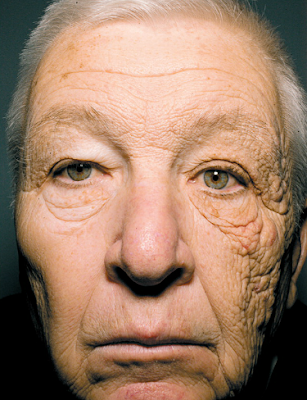Too much exposure to the rays may lead to sunburn and early aging of our skin. To expound, there are two types of UV rays which can be harmful. First is UVB (Ultra Violet - B). This type contributes primarily to sunburn and darkening of the skin. UV Type A on the other hand, contributes to sagging skin and wrinkles. Of course, skin cancer is also an issue, but with the rampant use of whitening products here in the Philippines coupled with the lack of concern for sunscreen application, I guess it is not important. Fuck cancer, at least I look sosyal, right? /s
 |
| UVA damage for 25 years exposure. From New England Journal of Medicine |
Before I proceed, I must say that sunscreen is a very tricky product which demands quite a number of readings. To name a few: physical and chemical filters, photoinstability, and SPF, PPD, and PA ratings. But that's why I'm writing this post just so you can have a gist and have a basic understanding for this product.
Choosing your sunscreen
1. Find a product which has an SPF of at least 30 and a PA+++ rating. As per this article on WebMD, an SPF 30 product can already absorb 97% of UVB rays. The Skin Cancer foundation recommends at least SPF 15, which can block 93% of the sun's UVB. As for the PA rating, as there is not much publication on the rating to be used, so my personal take is to take the highest PA+++ rating.
2. Check the ingredients. In the list, you can see the UV filters provided which will determine from which UV rays will be filtered. As a personal rule of thumb, I try to avoid the filters avobenzone and octyl methoxycinnamate to rid myself of the need to check the photostability of the sunscreen. In case your chosen sunscreen has these though, it is imperative to research on these UV filters and how to deal with their photoinstability - which is not too technical, but involves some memorization of the filter names). Meanwhile, I try to find zinc oxide in my sunscreen to cover for both UVA and UVB rays. Here is a sample ingredient list for my holy grail sunscreen (to be reviewed soon because my supply is running out!).
For reference, here is a list of the US-FDA approved UV filters and their applicability. Some new filters might not be in that list so GMG. (GMG = Google mo, gago.)
3. Time to test. Unfortunately, it is the usual case when we cannot test the sunscreen, especially if we only get it from online shops. In lieu with this, the next plan is to check for reviews for such products off the internet. Be careful of buying very expensive sunscreens (some go for more than 1500 php) because if it somehow will not work for you, it would be best to use it only on your body. Sunscreen for the body is way cheaper than sunscreen formulated for the face, so you might waste money if you're not careful.
I've tried a number of sunscreen from Japanese and Korean brands,which I will review also when time permits. Pero Shiseido, wala pa. "When money permits", din pala!
How to use it
Now that you've found a sunscreen you can use, here are some pointers on how to properly use it.
1. Apply the correct dosage. 2 mg/sq.cm is the application amount for which the sunscreen's rating is tested. So if you put less than that amount, you are not adequately protected. But wtf is 2 mg/sq.cm, Pigwin? I'm not an engineer! Hey,I'm an engineer but I cannot imagine that amount too. Good thing NIH has ball park values for use.
Face and neck : 1/2 teaspoon (1/4 teaspoon for face, 1/4 teaspoon for neck)
Arms and shoulders: 1 teaspoon
Torso: 1 teaspoon
Legs and top of feet: 2 teaspoons
 |
| A set of measuring spoons, with a peso above the 1/4 tsp. R to L: 1/4 tsp, 1/2 tsp, 1 tsp, and 1 tbsp. |
So that BB cream you put with tiny little dots and claim that it can provide an SPF 30 and PA++? Yeah, not gonna happen. It's either you put too much BB cream or put sunscreen on before your BB/makeup.
2. Apply every 2 hours. Although that time span is debatable, reapplication every 2 hours is recommended by various sources. Of course, this advice should be adjusted as necessary, as it would be completely pointless to apply every two hours when you're not even near a window during office hours. So for the women who must wear makeup and is somehow exposed to the sun, well, good luck. Or better buy something like this or this.
3. Apply at least 30 minutes before sun exposure. Most sunscreens are composed of both physical and chemical filters. Chemical filters need time some time to be functional, like those women who will not go out of their houses without at least a BB cream.
4. Rain or shine, put sunscreen. 80% of the sun rays can still reach us even on very cloudy days. Or again, find a UV blocking parasol and use it often.
So yep, it is not that hard. If you don't need to use your hands when exposed to then sun, better buy a parasol. Otherwise, a broad-spectrum sunscreen is your best anti-aging regimen.


0 comments:
Post a Comment
Hi, feel free to leave your comments here.